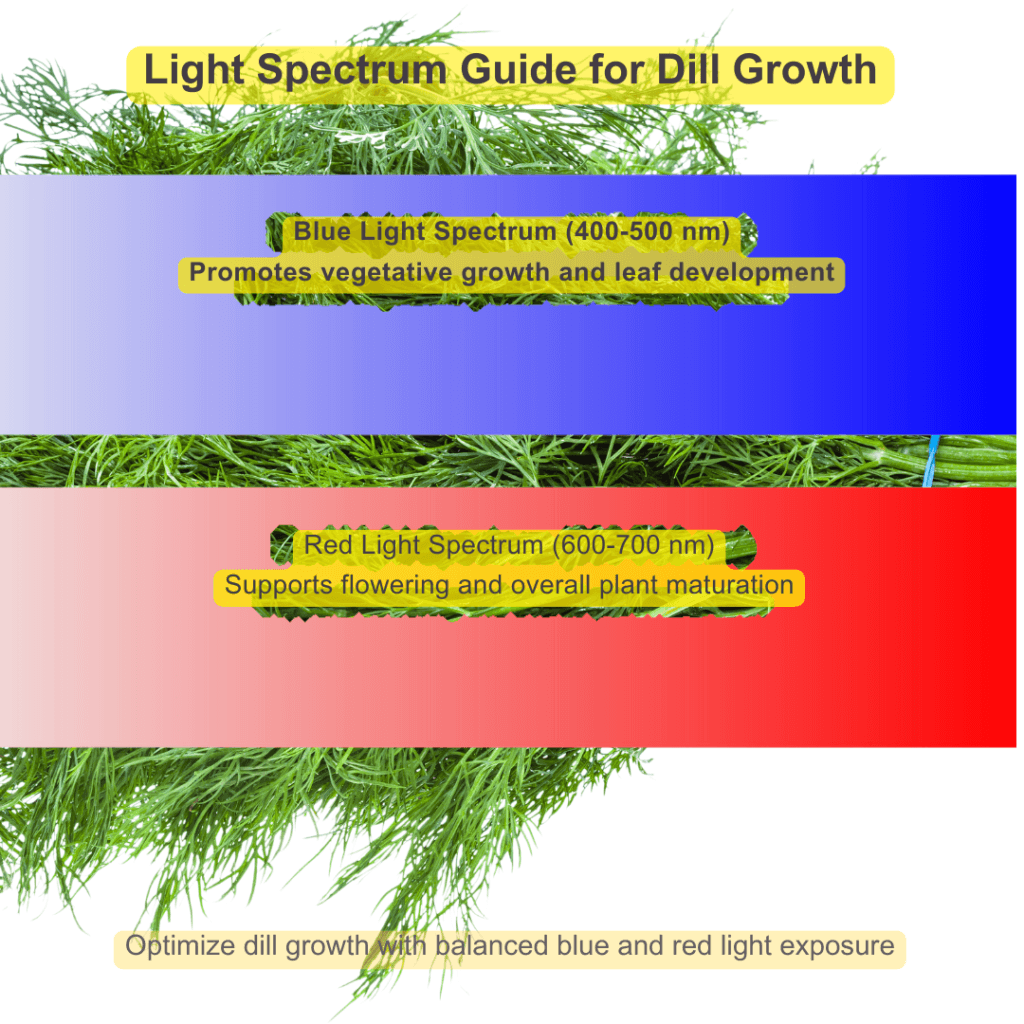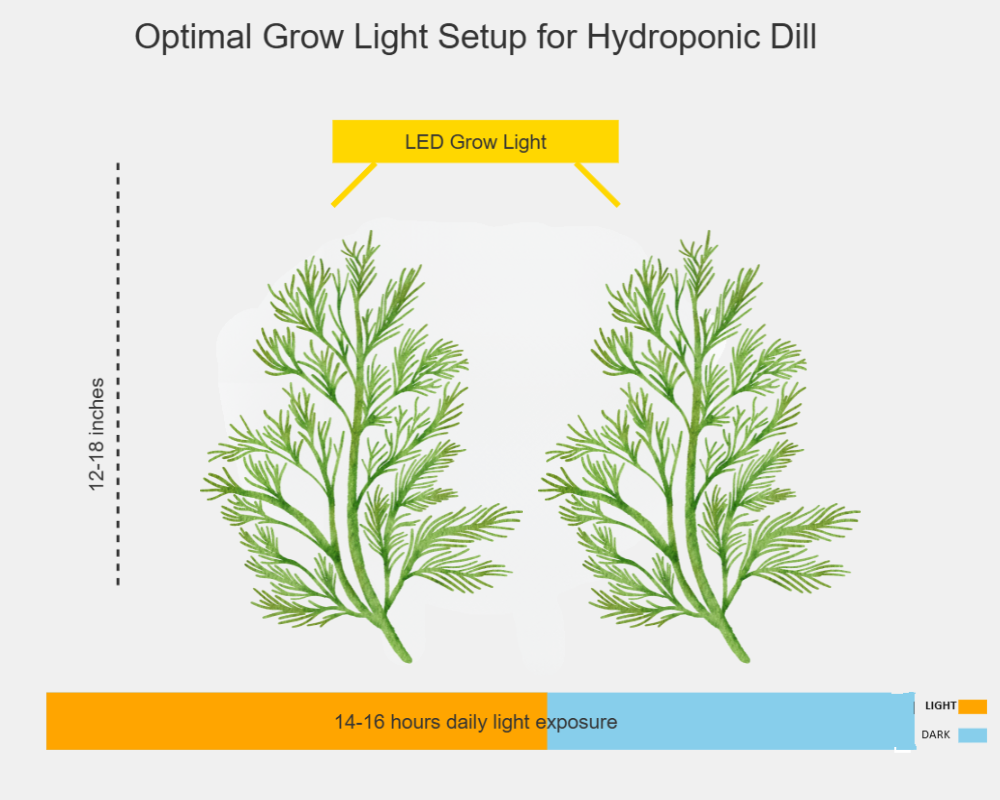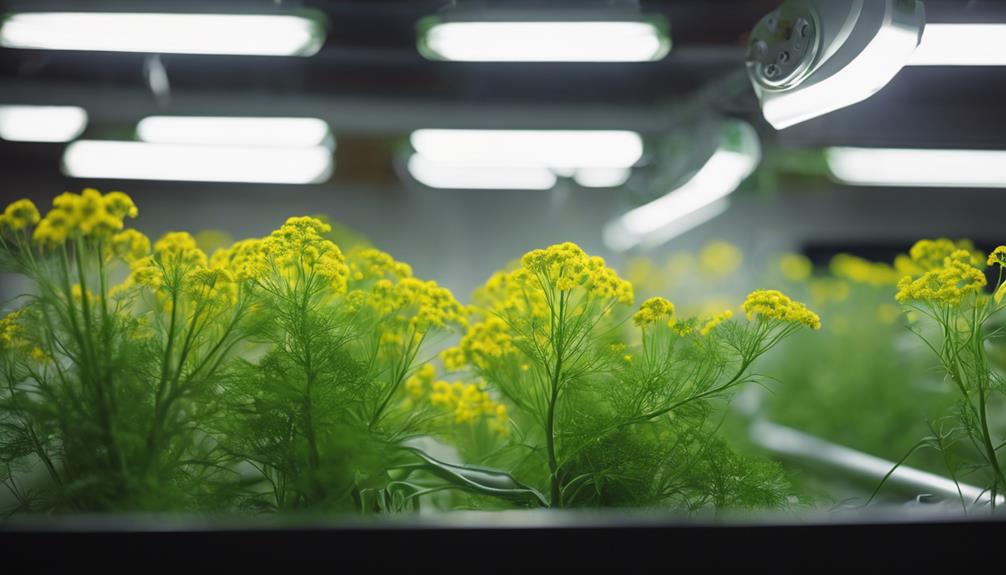Dill Growth with Grow Lights: An Introduction
How do you optimize your hydroponic dill growth with grow lights? Provide essential light spectrums for vegetative and flowering stages. LEDs, with blue and red spectrums, stimulate robust growth. These lights mimic natural sunlight, promoting healthy development and flavor. Choose LEDs for energy efficiency and longevity, maintaining peak conditions. Guarantee proper placement, 12-18 inches above plants. Also, 14-16 hours of daily exposure for ideal growth. Troubleshoot by checking connections and adjusting height for signs of light burn. Strategically adjust duration based on growth stage for dill’s best development. Learn more about maximizing dill growth with precise light spectrums.

Key Takeaways
- Choose LED grow lights with blue/red spectrums for vegetative and flowering stages.
- Position lights 12-18 inches above dill to prevent light burn.
- Provide 14-16 hours of daily light for robust growth.
- Ensure even light coverage to avoid growth irregularities.
- Troubleshoot issues like light burn, uneven growth, or decreased light output promptly.
How do Grow Lights for Hydroponic Dill Help it Grow?
Understanding the role of grow lights is essential for optimizing dill growth in your hydroponic system. Dill plants rely on the right light spectrum for photosynthesis. This is important for their development.
Grow lights, particularly LEDs, mimic the sun’s rays. They provide dill with the necessary blue and red light spectrums. These are important for both vegetative growth and flowering stages. LEDs offer energy efficiency and longevity. This makes them ideal for sustaining ideal light conditions for your dill plants.
To guarantee robust growth one needs to maintain proper light intensity and coverage in your hydroponic setup. Different grow lights have different effects on dill cultivation. By understanding this, you can cultivate healthier plants. Further, it enhances flavor profiles, and maximizes your hydroponic herb garden’s productivity.
Explore the science behind grow lights. Learn about the full potential of your dill cultivation endeavors.
What Are the Benefits of Using Grow Lights?
LED grow lights in your hydroponic setup can effectively simulate natural sunlight. This helps promote healthy growth and development in your dill plants.
These energy-efficient lights provide specific light spectrums. These spectrums are essential for different growth stages. Blue light aids in vegetative growth. Red light is essential for flowering stages.
LED grow lights are a sustainable and long-lasting option for indoor hydroponic gardens. They ensure ideal photosynthesis and nutrient absorption in your dill plants.
Properly utilizing grow lights guarantees consistent light exposure. This leads to enhanced plant health and flavor development in your hydroponically grown dill.
You should strategically place grow lights and adjust their light intensity and duration. Then, you can maximize the growth potential of your dill plants. Further, you can achieve a bountiful harvest in your hydroponic herb garden.
How do you Choose the Right Grow Lights For Dill?

Select grow lights for your hydroponic dill by evaluating the light spectrum for different growth stages. Blue light is important for vegetative growth. Red light supports flowering in dill plants. Additionally, consider intensity control to meet the specific needs of growing dill hydroponically.
It is essential to guarantee energy efficiency in your setup. So, compare LED lights for lower energy consumption when choosing a grow light.
Match the coverage area of the light to your indoor hydroponic garden size. This makes sure all dill plants receive sufficient light for ideal growth. Be sure to invest in quality grow lights. This will provide durability and long-term benefits. Further, it promotes healthy and robust dill growth in hydroponic systems.
| Aspect | Importance | Consideration |
|---|---|---|
| Light Spectrum | High | Blue for vegetative growth, red for flowering |
| Intensity Control | Medium | Adjust for specific plant needs |
| Energy Efficiency | High | Choose LED for lower consumption |
Choose wisely to ensure your dill plants thrive under the right conditions.
How do you Optimize Light Placement and Duration?

Enhance your hydroponic dill growth by focusing on positioning grow lights. Then adjust their duration for best results. Here are some key tips to optimize light placement and duration for healthy growth and maximizing growth potential:
- Place grow lights 12-18 inches above dill plants: This prevents light burn. Further, it ensures that there is adequate light for photosynthesis without causing stress.
- Provide 14-16 hours of light daily: It mimics natural sunlight. By doing so, it promotes healthy development and robust growth in your dill plants.
- Adjust light duration based on growth stage: Increase light exposure as your dill matures. This supports increased photosynthesis needs and overall plant development.
- Ensure even light coverage: Distribute light evenly across your dill growing area. This prevents uneven growth patterns and promotes consistent plant health.
Proper light placement and duration are vital factors in optimizing your hydroponic dill growth. It ultimately leads to flavorful and abundant harvests.
Troubleshooting Grow Light Issues

Experiencing issues with your grow lights?
- Assess for loose connections or electrical problems to troubleshoot effectively. Loose connections can hinder the proper functioning of your grow lights, so make sure all components are securely in place.
- Plants are showing signs of light burn, like wilting or yellowing leaves. Adjust the height or duration of the light exposure to prevent damage. Remember to regularly rotate your plants. This will guarantee even light distribution and avoid any growth irregularities.
What did we learn about Hydroponic Dill Growth with Grow Lights?
- Incorporating grow lights into your setup is essential. It allows you to maximize the growth and productivity of your hydroponic dill:
- Provide the right light spectrum for photosynthesis. By doing so, grow lights can greatly enhance the health and yield of your plants.
- Carefully place and adjust the lights. Then you can optimize dill growth, flavor, and overall output in your herb garden.
Remember to invest in the right grow lights. This will take your hydroponic dill cultivation to the next level.

